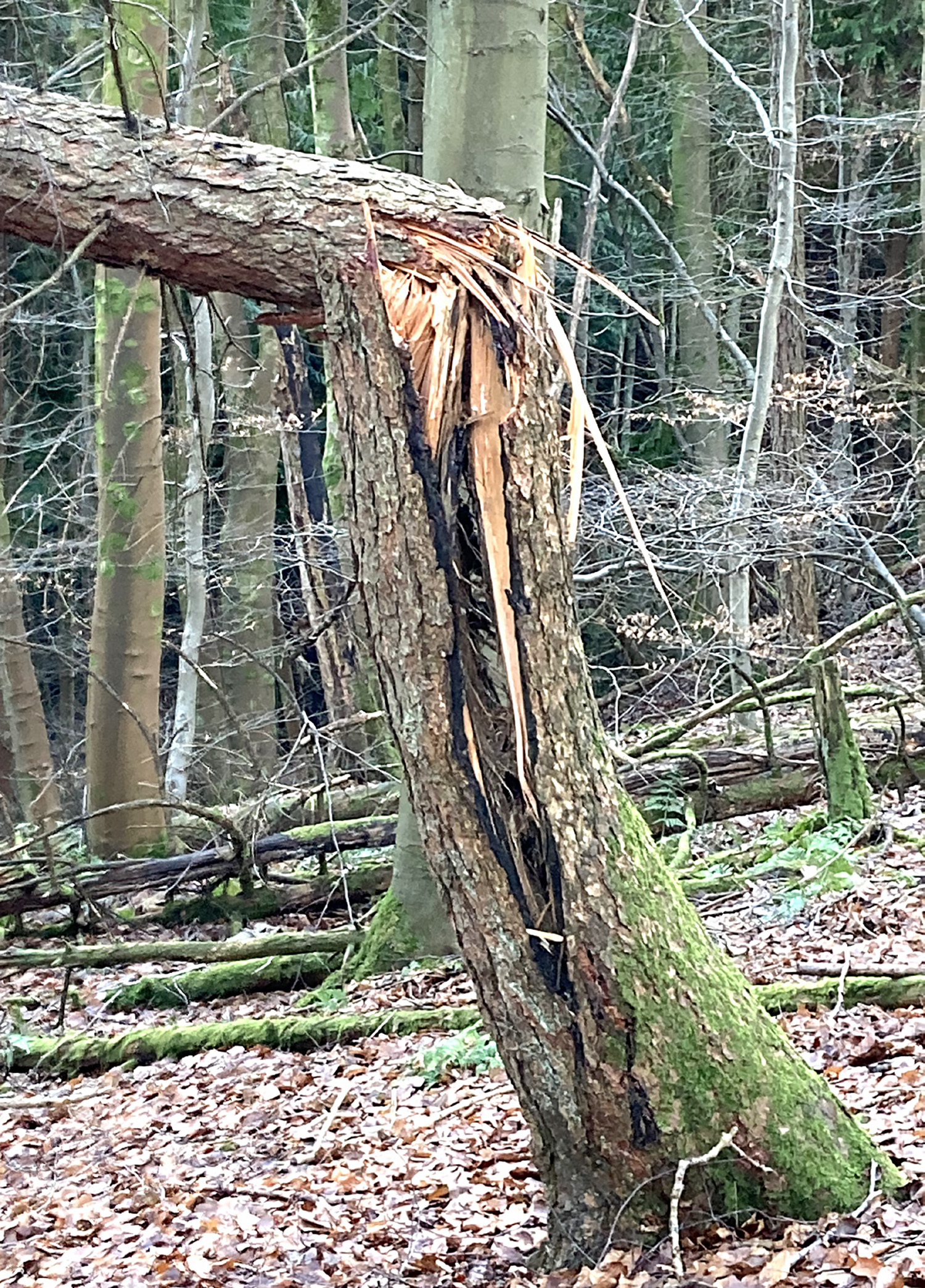Chris Simpson

Buckled larch whip with pre-existing hazard beam.
Rubber-necking is seriously frowned upon. Miles of tail-backs just because drivers want a glimpse of someone else’s misfortune. But who is not guilty of rubbernecking? It’s human nature, surely?
Over the years I have become something of a woodland rubber-necker. It is always interesting to try and determine the cause of a tree’s structural failure. In the woods you can take as long as you like staring at the tree’s misfortune without causing congestion. Little did the younger version of me realise that assessing the cause of tree failures would become a skill set that is in demand. Loss-adjusters, solicitors and advocates are all keen to determine why that tree failed, because once the cause is confirmed the matter of foreseeability can be addressed.
I had, perhaps, severed and chokered hundreds, if not thousands, of wind-thrown spruce trees before realising that few of them had failed. Rather, it was the soil they were rooted in that had sheared. That silvicultural background also introduced me to the term ‘whip’. A forester targets whips when marking a selective thinning: overly slender specimens that are likely to damage neighbouring trees and equally unlikely to ever produce more than chipwood or pulpwood. I find the term useful when describing trees during surveys.
Foresters also have a disdain for trees with ‘sweep’. Those leaning trees that lay down reaction wood to straighten themselves will display sweep. Sweep can be used to determine when the lean developed and how the tree has responded since. The disdain is because if you cannot draw a straight line along the butt (get the ripsaw to plank that butt) then the woodcutter has no choice but to down-grade it to chipwood; sore on everybody’s pocket.
I walk past a hybrid larch (Larix × marschlinsii) regularly. This ‘whip’ has an extremely unfavourable slenderness ratio, as many forest-grown conifers do. What has made this particular tree interesting is the longstanding ‘hazard beam’ on its sweeping lower bole. The term hazard beam will be nothing new to you, but I note that many only seem to use it to describe split limbs – typically those large-diameter, up-sweeping, lower first-order laterals – though the term does also apply to those split lower boles. You will also be aware that they are self-limiting cracks. Hazard beams are not creeping failures.
Recent high winds finally generated enough compressive and tensile forces to overload my skinny friend’s woody fibres, resulting in fibre buckling and tearing. The snapped stem is now resting on its equally skinny neighbours. The interesting facet of this latest structural failure is its positioning. The fibres buckled just above the tip of the hazard beam (see photograph). This whip did not fail at the existing crack, or below it. The roots did not shear; the soil did not shear. The lower, sweeping, already-split bole resisted the bending forces better than the largely intact upper bole.
What does this particular failure pattern tell us? Well, ‘hazard beams’ are not hazardous. They allow us to look back in time and determine the loading previously exerted on that bole, or limb – often in the distant past. Look at the ‘ram’s horn’ development around the crack’s peripheries: it will give you a good idea of when the stem ‘failed’. They are little to worry about; I cannot ever recall feeling the need to intervene. And a word of caution, I have seen bats emerge from them – more than once. But they are wounds. Sapwood, heartwood or ripewood is exposed and aerated, making the development of some internal decay probable. My whippy friend did have some centralised decay developing and perhaps this was just enough to create something of a stress notch, at the point of failure.
More than that, I have often wondered if that hazard beam is now actually stronger (more resistant to catastrophic failure) than when it was intact. Do those ribs of differentiated wood along the crack’s edges, combined with its open form, mean it is more capable of resisting transverse loading? I regularly walk under a prostrate horse chestnut (Aesculus hippocastanum) trunk with an old hazard beam and always feel like I am in a mechanic’s pit looking at the leaf suspension on a car. A useful, if unintentional, adaptation of form? In summary, my hybrid larch whip reassures me that hazard beams are little to worry about. Keep the saw in its scabbard for now. In this case, an unfavourable height-to-diameter ratio was more significant, for structural integrity, than a historic crack.
Further reading
Mattheck, C. and H. Breloer (1994). The Body Language of Trees: A Handbook for Failure Analysis. HM Stationery Office
Mattheck, C., K. Bethge and K. Weber (2015). The Body Language of Trees: Encyclopaedia of Visual Tree Assessment. Forschungszentrum Karlsruhe GmbH
Mattheck, C. (2002). Tree Mechanics: Explained with Sensitive Words by Pauli the Bear. Forschungszentrum Karlsruhe GmbH
Chris Simpson is a Fellow of the Association and past Chair of the Scotland Branch. He is a Chartered Forester, Member of the Expert Witness Institute, Lantra Instructor and City & Guilds assessor who has over 35 years’ experience in the industry. Chris’s work is focused on assessing the safety of urban trees and providing advice to landowners.
This article was taken from Issue 204 Spring 2024 of the ARB Magazine, which is available to view free to members by simply logging in to the website and viewing your profile area.